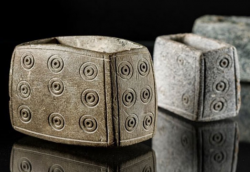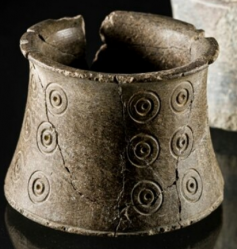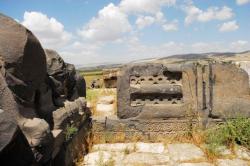INSTITUT SUPERIEUR D'ANTHROPOLOGIE
INSTITUTE OF ANTHROPOLOGY
ONLINE COURSES / COURS A DISTANCE
SPRING TERM : APRIL 2018
REGISTER NOW
OMAN –

 - Qumira - The archaeological digs revealed three settlements in the area of Qumira in Ain Bani Saada: a cemetery dating back to the third millennium B.C.; a Neolithic settlement; and a settlement dating from the Bronze Age to the Iron Age. The location of Qumira made it a trade hub for copper trade, in addition to the availability of water. Settlements continued to flourish for a long period of time, dating from the third millennium to the first century B.C. and the Islamic period. The cemetery that was excavated dates back to the third millennium B.C., and contained four burial chambers. Numerous skeletal remains were found with many funerary artefacts, including pottery vessels, stones, beads and arrows. Archaeological excavations at the second site revealed a settlement of several residential buildings built on stone foundations, including a circular tower. A number of local and imported pottery fragments were found in this settlement. The third site was that of a Bronze Age settlement that survived through the Iron Age and the late Islamic period. These buildings were built on stone foundations with complex divisions. This settlement was connected to three stone towers. One of those being similar to the Rajum Tower in the archaeological site of Bat, which also features its curved ring wall.
- Qumira - The archaeological digs revealed three settlements in the area of Qumira in Ain Bani Saada: a cemetery dating back to the third millennium B.C.; a Neolithic settlement; and a settlement dating from the Bronze Age to the Iron Age. The location of Qumira made it a trade hub for copper trade, in addition to the availability of water. Settlements continued to flourish for a long period of time, dating from the third millennium to the first century B.C. and the Islamic period. The cemetery that was excavated dates back to the third millennium B.C., and contained four burial chambers. Numerous skeletal remains were found with many funerary artefacts, including pottery vessels, stones, beads and arrows. Archaeological excavations at the second site revealed a settlement of several residential buildings built on stone foundations, including a circular tower. A number of local and imported pottery fragments were found in this settlement. The third site was that of a Bronze Age settlement that survived through the Iron Age and the late Islamic period. These buildings were built on stone foundations with complex divisions. This settlement was connected to three stone towers. One of those being similar to the Rajum Tower in the archaeological site of Bat, which also features its curved ring wall.
http://timesofoman.com/article/127209/Oman/Three-important-archaeological-sites-unearthed-in-Oman
CHINE - Nanchang - Archaeologists have finished unearthing an ancient tomb dating back 2,000 years ago in east China's Jiangxi Province. The tomb, 4 meters long and 4 meters wide, can be traced back to the Eastern Han Dynasty (25 A.D.- 220 A.D.), said Yang Jun, who leads the excavation work. The tomb is one of 11 tombs discovered in July last year at a construction site in Nanchang, capital of Jiangxi. Archaeologists said the tombs were built in different periods of history. Experts ascertained the time of the tomb based on coins unearthed from the underground chambers, he said. "The tomb is made from bricks and wooden structures. Funeral objects included lacquered containers and textiles," Yang said. Archaeologists said the body of an adult woman and the bodies of five children, aged between five to 14, were found in the tomb. "The tomb is rather uncustomary because usually there is a body of a male in the chamber, but oddly there is none in this one. We are still studying to make out the relations between the female and the children," Yang said. Nanchang is home to many cemeteries dating back thousands of years. In 2015, the tomb of the Marquis of Haihun was unearthed near Nanchang. The tomb is part of China's most complete Western Han Dynasty (206 B.C.- 25 A.D.) cemetery. More than 10,000 artifacts have been unearthed so far.
http://www.xinhuanet.com/english/2018-01/30/c_136936765.htm
ISRAEL –  Beit She'an - Two Israeli families hiking near the Harod Stream in Beit She'an's National Park in northern Israel discovered a Byzantine-era pitcher. The strong rains falling near Beit She'an exposed soil at the site, which is known to be filled with antiquities. The IAA's Dr. Walid Atrash added that "the hikers found a Byzantine jug, which was preserved in its entirety. The jug is from the sixth or seventh century of the Common Era. These types of jugs served to store wheat and legumes such as beans and chickpeas. Not far from here, there is a magnificent church and an ancient cemetery, and it makes sense that the jug was placed on one of the graves as part of a ritual, and was swept towards this area over time."
Beit She'an - Two Israeli families hiking near the Harod Stream in Beit She'an's National Park in northern Israel discovered a Byzantine-era pitcher. The strong rains falling near Beit She'an exposed soil at the site, which is known to be filled with antiquities. The IAA's Dr. Walid Atrash added that "the hikers found a Byzantine jug, which was preserved in its entirety. The jug is from the sixth or seventh century of the Common Era. These types of jugs served to store wheat and legumes such as beans and chickpeas. Not far from here, there is a magnificent church and an ancient cemetery, and it makes sense that the jug was placed on one of the graves as part of a ritual, and was swept towards this area over time."
https://www.israelnationalnews.com/News/News.aspx/241340
SYRIE – 
 Ain Dara - Much of the magnificent 3,000-year-old temple of Ain Dara, with its mysterious and massive footprints and a structure that provides clues for understanding the biblical temple of Solomon in Jerusalem, has been destroyed in a Turkish airstrike. The temple, one of the largest and most extensively ancient excavated structures in Syria, is famous for its intricate stone sculptures of lions and sphinxes, and for its similarities to Solomon’s Temple—the first Jewish temple in Jerusalem, said to have held the Ark of the Covenant. A Turkish airstrike destroyed much of the temple on Friday during an attack on the Kurdish-held area south of the city of Afrin, according to the Syrian Ministry of Cultureand the Syrian Observatory for Human Rights. Photos and video from the Syrian Observatory and Hawar News confirm that more than half of the temple is gone, including many of the sculptures that ringed the site. The temple at Ain Dara was built more than 3,000 years ago, around 1300 B.C, a time just before Bronze Age kingdoms began to collapse in the Eastern Mediterranean.
Ain Dara - Much of the magnificent 3,000-year-old temple of Ain Dara, with its mysterious and massive footprints and a structure that provides clues for understanding the biblical temple of Solomon in Jerusalem, has been destroyed in a Turkish airstrike. The temple, one of the largest and most extensively ancient excavated structures in Syria, is famous for its intricate stone sculptures of lions and sphinxes, and for its similarities to Solomon’s Temple—the first Jewish temple in Jerusalem, said to have held the Ark of the Covenant. A Turkish airstrike destroyed much of the temple on Friday during an attack on the Kurdish-held area south of the city of Afrin, according to the Syrian Ministry of Cultureand the Syrian Observatory for Human Rights. Photos and video from the Syrian Observatory and Hawar News confirm that more than half of the temple is gone, including many of the sculptures that ringed the site. The temple at Ain Dara was built more than 3,000 years ago, around 1300 B.C, a time just before Bronze Age kingdoms began to collapse in the Eastern Mediterranean.
https://news.nationalgeographic.com/2018/01/syria-temple-ain-dara-destroyed-archaeology/
NEPAL – Lumbini - After fresh geophysical survey and excavation carried out in Tilaurakot, Lumbini, archaeologists have come to the conclusion that there existed a city somewhere around 1300 BC in Lumbini. They came to the conclusion after studying the remnants of ancient infrastructure found during the excavation. Spokesperson of DoA Ram Bahadur Kunwar said preliminary results of the study showed that the birthplace of Lord Buddha used to be a centre of human civilisation thousands of years before the birth of Buddha. Kunwar also said various artifacts and ancient infrastructure found in Lumbini had already proved that once there was one of the oldest cities of South Asia. “And recent surveys and excavations have found even stronger proof that there was a well-planned city which was an architectural masterpiece,” he added. “Recent surveys have substantiated our findings of earlier surveys. Recent surveys have provided us with evidence that can prove that once there existed rich human civilisation with roads, forts and wells, among other infrastructure,” spokesperson Kunwar said. The DoA came to this conclusion after the survey report of areas such as Ram-gram, Sagarhawa and Chatradehi. The intensive three-year survey was held in different phases in Lumbini from 2011 onward with the help of UNESCO Japanese Funding Trust. The recent archaeological survey was supported by Lumbini Hotel Kasai. Meanwhile, archaeologists are also excavating the vicinity of Samayamai temple and the area of Tilaurakot. It is said that Gautam Buddha lived from 563 BC to 483 BC. The recent findings could also be helpful to know more about the Buddha who was a prince of the royal family of Shakyas. Archaeologists also believe that if it is proved that the artifacts and relics excavated from the site were as old as they have predicted, then Lumbini civilisation could be one of the oldest civilisations in South Asia.
https://thehimalayantimes.com/kathmandu/civilisation-existed-lumbini-1300-bc/
CHINE - Kaifeng - A square that once served as military defense area in ancient China has been unearthed in the central Province of Henan. Known as Wengcheng in Chinese, it is the earliest square defense area ever discovered in China, according to Liu Haiwang, head of the Henan Provincial Institute of Cultural Heritage and Archaeology. The defense area was discovered in Henan's Kaifeng City, which once served as the capital of eight dynasties in China. "The discovery provided valuable materials for research about the layout of the capital city of the Northern Song Dynasty (960-1127), the evolution of gates in ancient Chinese capitals and the history of Kaifeng's development," Liu said. Wengcheng was usually built in military fortresses before the Tang Dynasty (618-907). It began to be part of city construction during the Song Dynasty (960-1279).
http://www.xinhuanet.com/english/2018-01/30/c_136936794.htm